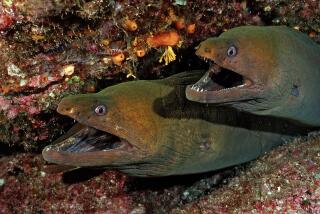Penis fish and sea pickles: Weird creatures wash ashore amid Northern California storms
Beachgoers may have found themselves in quite a pickle last week trying to identify thousands of gelatinous sea creatures that washed ashore during a strong storm in Northern California.
Molly Knight, a sportswriter for the Athletic, stumbled on the pebbled-surfaced creatures on the sand at Carmel Beach on Thursday, snapped a photo and asked Twitter to help her figure out what they were. The Monterey Bay Aquarium responded, explaining that big waves and strong currents pushed pyrosomes — formally known as Pyrosoma and colloquially called sea pickles — onto the beach.
“Though similar in appearance to ‘penis fish’ fat innkeeper worms when washed up, pyrosomes are in fact planktonic colonies of filter feeders some call sea pickles,” the aquarium wrote on Twitter. “Always something fun on the beach!”
The next day aquarium employees visited Asilomar State Beach in Pacific Grove, where thousands of the tubular tunicates had also washed up, and explained a little more about them in a video.
Pyrosome, meaning “fire bodies,” is a nod to the creature’s bioluminescence. While on land, the cigar-shaped organisms appear to be a pale shade of pink. However, in the ocean, they are bright pink and create their own blue and green light, Patrick Webster, an aquarium employee, said in the video.
Webster said the creatures look similar to the fat innkeeper worms, known as penis fish, that washed up on Drake’s Beach in Marin County earlier this month. But unlike those animals, which burrow in the sand, pyrosomes are drifters that float along with ocean currents.
“We’re taking a look at this really amazing phenomenon that happens every once in awhile,” Webster said in the video. “There are just countless hordes of them.”
The sea pickles, which are typically found in warm tropical waters, have been spotted more often in Northern California, Alaska and Canada in recent years. Science magazine reported in February that the pyrosomes’ more frequent appearance in cooler areas could be the result of an oceanic heat wave that has swept across the west coast of North America.
Scientists have been trying to study pyrosomes for years but have been hampered by the creatures’ short lifespan in captivity and elusive nature in the wild, according to the publication.
More to Read
Sign up for Essential California
The most important California stories and recommendations in your inbox every morning.
You may occasionally receive promotional content from the Los Angeles Times.











